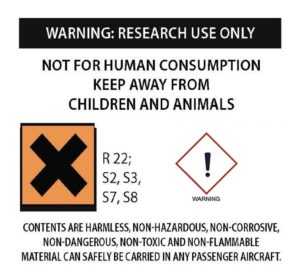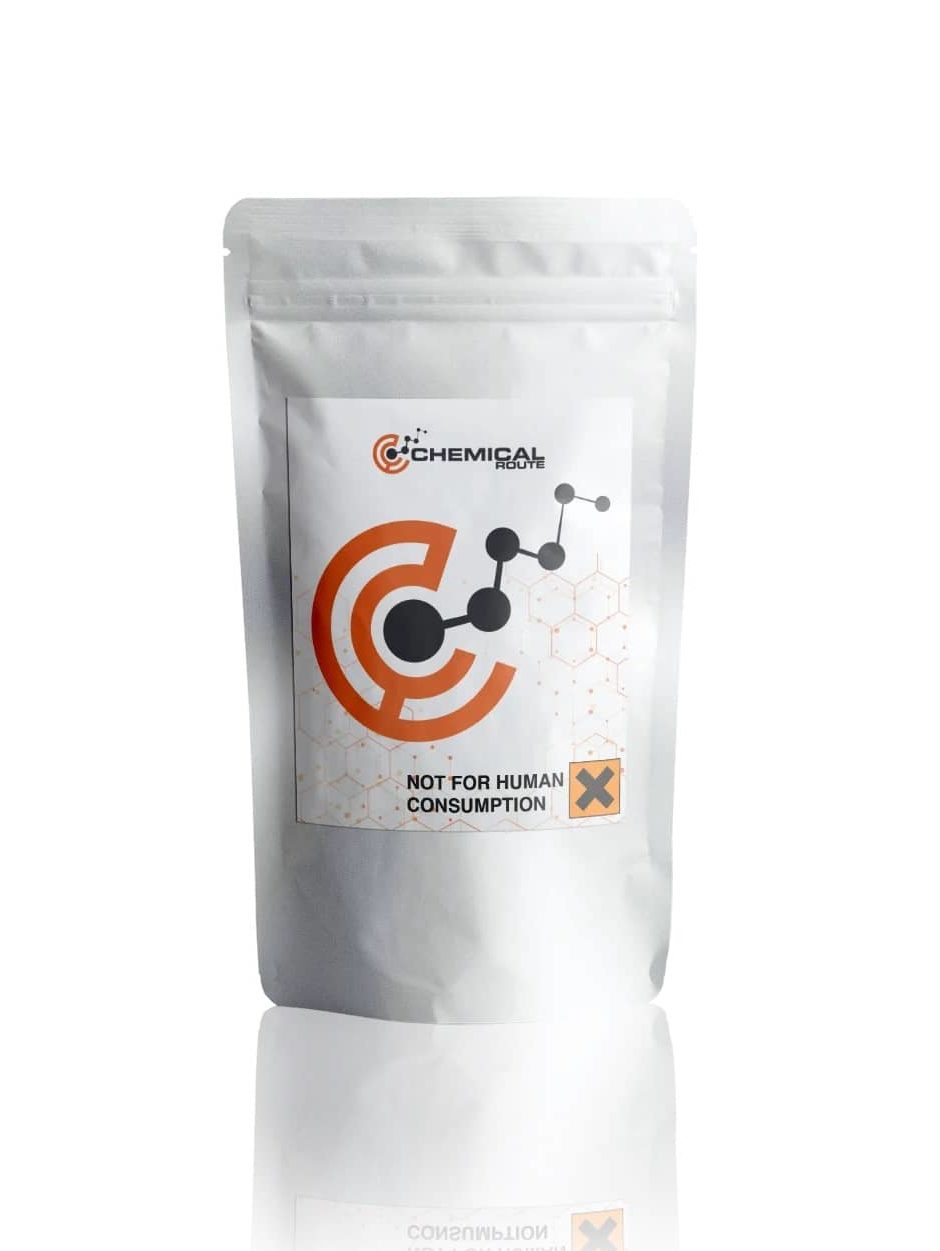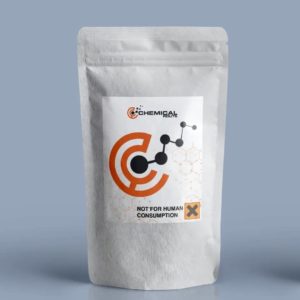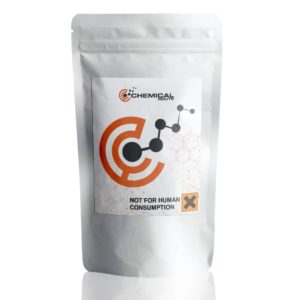Description
Diphenidine, 1,2-DEP, DPD, DND
Product information
IUPAC-name (±)-1-(1,2-Diphenylethyl)piperidine
Synonyms Diphenidine, 1,2-DEP, DPD, DND
Formal name 1-
Cas number 28383-15-5
Formula C19H23N • HCl
Formula Weight 301.9
Purity 99.0 % min.
Formulations A neat solid, Powder
Solubility
- DMF: 10 mg/ml
- DMSO: 5 mg/ml
- Ethanol: 5 mg/ml
- PBS (pH 7.2): 5 mg/ml
2,5-dimethoxy-4-chloroamphetamine, DOC
Diphenidine, which is a dissociative anesthetic, has been marketed as a designer drug. The first known synthesis of this drug was reported in 1924. It was performed using a Bruylants reaction, which is similar to the one that would be used to discover the phencyclidine. Following the 2013 UK ban on the use of arylcyclohexylamines in the production of drugs, the drug became available on the black market.
According to some reports, high levels of diphenidine are known to trigger various sensory phenomena such as a somatosensory amnesia and transient anterograde amnesia. In vitro studies have shown that the drug can be used as a treatment for neurotoxic injuries. It exhibits better antitussive properties than the codeine phosphate.
Diphenidine is a novel substance in the diarylethylamine class that is structurally similar to the drugs ephenidine and methoxphenidine. It is also known as DND, DPH, and DPD. It is regarded as a receptor antagonist of the NMDA.
The first known synthesis of diphenidine was performed in 1924. It wasn’t selected for further development. Following the 2013 ban on the production of arylcyclohexylamine in the UK, the drug and its analogue, methoxphenidine, became readily available on the grey market. Two cases of illicit use of diphenidine were reported in 2014 in Japan, and one of these led to a fatal overdose.
A study conducted on the effects of diphenidine and ketamine on the formation of fEPSPs revealed that the former exhibited a slower onset of antagonism compared to the latter. The two enantiomers of diphenidine have different capabilities when it comes to blocking the receptor of the NMDA. The S-enantiomer has an advantage over the R-enantiomer, as it has an exceptionally high affinity for the receptor.
Since the introduction of diphenidine in 2013, vendors have claimed that it can act on the dopamine transport system. However, until 2016, no studies have been published on the activity of this drug on the dopamine transporter. Although it has an exceptionally high affinity for the receptor, it also has submicromolar affinities for other receptors.
In 2014, there were reports of Japanese companies selling various chemicals, including diphenidine, in combination with herbal incense blends. The first seizure was made after a product known as “fragrance powder” was found to contain benzylpiperazine and diphenidine.
A product known as “Aladdin Spacial Edition” was found to contain high levels of diphenidine and 5F-AB-PINACA. It was also produced in the Shizuoka Prefecture and sold under the name “Super Lemon.” According to reports, the product was linked to a fatal poisoning. In addition to diphenidine, the Super Lemon also contained other chemicals, such as alcohol and three types of benzodiazepines. In Japan, several people died after accidentally consuming bath salts and liquid aroma products.
In Canada, the analogues of MT-45 and diphenidine were classified as Schedule I substances, which means they can be considered dangerous.Possessing them without authority can result in up to seven years in prison. In 2016, Health Canada also added DND to the list of restricted substances. Only those who have a valid exemption permit and are authorized to possess the drug can be allowed to do so.
The effects of these drugs include a variety of psychological and physiological conditions. Some of these include pain relief, motor control loss, and internal hallucinations. In addition, they can also trigger a complex mental state known as dissociation.
People who have used high levels of diphenidine reported experiencing a variety of bizarre somatosensory effects, such as amnesia. The effects of these drugs are similar to those of other drugs, such as phencyclidine and ketamine.
Due to the lack of reliable data regarding the effects of diphenidine on humans, it is not possible to determine if it is safe to use. It is also possible that it could pose a different safety risk compared to traditional dissociatives. Because of this, it is highly advised to avoid using this substance.
Chemistry
Diphenidine is a component of the diarylethylamine class. It has a basic skeleton composed of phenethylamine with a substituted R in the phenyl ring. It is structurally similar to the polymorpholino xylose (MXP). Since it is part of a dissociative class, it is also known to have an amino group attached through the phenethylamine chain.
Pharmacology
Diphenidine is a drug that can block the function of the neuromodulators, known as the NMDA receptors. These are located in the spinal column and brain. When activated, these receptors allow electrical signals to pass between the spinal column and the brain. However, when these signals are not received, the neurons are unable to feel or move. Eventually, this condition leads to the famous “hole.”
Although the vendors of diphenidine claim that it can block the function of the serotonin and dopamine receptors, it has not been studied for its ability to affect the µ-opioid receptor. This could mean that it provides an explanation for the drug’s stimulating and euphoric effects.
In vitro studies have shown that the use of diphenidine and other diarylethylamines can be useful in treating neurotoxic injuries. It is believed that the drug can block the function of the multiple receptor structures of the NMDA. Some of the other drugs that can block the function of this receptor are dextromethorphan, Iboga, and ketamine.
The toxicological and physiological properties of this compound has not been analyzed. Usage of this Chemical should be for research and forensic purposes only.
WARNING This product is not for human or veterinary use.

This product is only available to persons of 21 years old and above.
Hazard statement(s)
| H302 | Harmful if swallowed |
| H315 | Causes skin irritation |
| H319 | Causes serious eye irritation |
| H332 | Harmful if inhaled |
| H335 | cause respiratory irritation |
| H336 | cause drowsiness or dizziness |
| Precautionary statement(s) | |
| P264 | Wash hands thoroughly after handling |
| P280 | protective gloves/protective clothing/eye protection/face protection |
| P305 + P351 + P338 | IF IN EYES: Rinse cautiously with for several minutes. Remove contact lenses, if present and easy to do. Continue rinsing. |
| P337 + P313 | If eye irritation persists: Get medical advice/attention |
| P261 | Avoid breathing dust/ fume/ gas/ mist/ vapors/ spray |
| P271 | Use only outdoors or in a well-ventilated area |
| P304 + P340 | IF INHALED: Remove victim to fresh air and keep at rest in a position comfortable for breathing |
| P312 | Call a POISON CENTER or doctor/physician if you feel unwell |
| P403 + P233 | Store in a well-ventilated place. Keep container tightly closed |
| P405 | Store locked up |
| P501 | Dispose of contents/container to a licensed disposal company |




Reviews
There are no reviews yet.